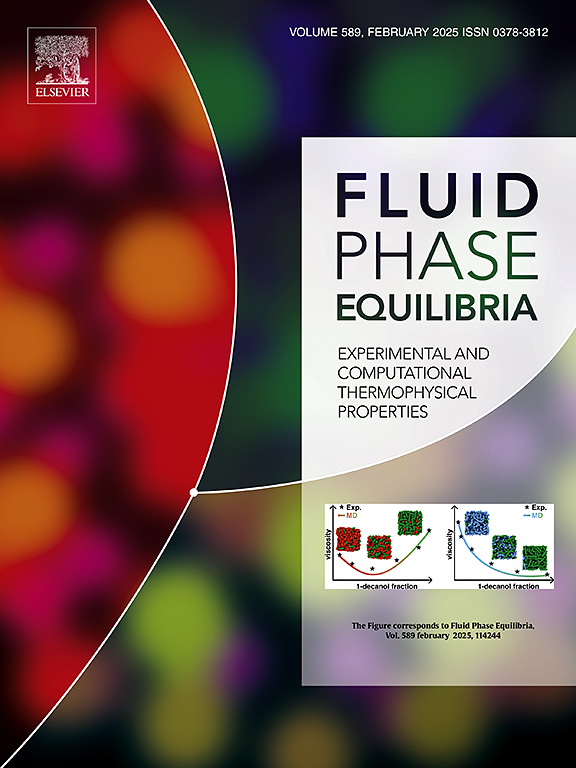水在沥青中的溶解度
IF 2.7
3区 工程技术
Q3 CHEMISTRY, PHYSICAL
引用次数: 0
摘要
采用等温逐步体积膨胀法测量了沥青和水的假二元混合物的液/液-气(L/LV)和水-液/水-液-气(AL/ALV)边界,测量条件与原地重油作业相关(温度为 180 至 280 °C,压力为 1.5 至 5 兆帕)。L/AL 边界是根据 L/LV 和 AL/ALV 边界的交叉点确定的。使用伪二元系统的活度系数模型来检查 L/LV 测量的自洽性。高级彭-罗宾逊状态方程对水具有独特的阿尔法函数,该方程被用来建立 VLE 和 VLLE 数据模型。在该模型中,根据 SimDist 分析以及油的比重和沥青质含量,将油表征为伪组分。对沥青伪组分和水之间与温度相关的二元相互作用参数进行了调整,使模型与测量结果的吻合度在实验误差范围内。为伪二元混合物生成了各温度下的等温压力-成分相图。最后,利用本研究和文献中的数据,建立了水在沥青中的溶解度极限随温度变化的直接相关关系。相关性的平均偏差在 340 °C 以下为 0.5 wt %。本文章由计算机程序翻译,如有差异,请以英文原文为准。
Solubility of water in bitumen
Liquid/liquid-vapor (L/LV) and aqueous-liquid/aqueous-liquid-vapor (AL/ALV) boundaries of pseudo-binary mixtures of bitumen and water were measured using the isothermal stepwise volume expansion method at conditions relevant to in situ heavy oil operations (temperatures from 180 to 280 °C and pressures from 1.5 to 5 MPa). The L/AL boundary was determined from the intersection of the L/LV and AL/ALV boundaries. An activity coefficient model of the pseudo-binary system was used to check the self-consistency of the L/LV measurements. The Advanced Peng Robinson equation of state, which has a distinct alpha function for water, was used to model the VLE and VLLE data. For this model, the oil was characterized into pseudo-components based on a SimDist assay and the specific gravity and asphaltene content of the oil. Temperature dependent binary interaction parameters between bitumen pseudo-components and water were tuned such that the model fit the measurements to within the experimental error. Isothermal pressure-composition phase diagrams were generated for the pseudo-binary mixtures at each temperature. Finally, a straightforward correlation for the solubility limit of water in bitumen as a function of temperature was developed using the data in this study and from the literature. The average deviation of the correlation was 0.5 wt % below 340 °C.
求助全文
通过发布文献求助,成功后即可免费获取论文全文。
去求助
来源期刊

Fluid Phase Equilibria
工程技术-工程:化工
CiteScore
5.30
自引率
15.40%
发文量
223
审稿时长
53 days
期刊介绍:
Fluid Phase Equilibria publishes high-quality papers dealing with experimental, theoretical, and applied research related to equilibrium and transport properties of fluids, solids, and interfaces. Subjects of interest include physical/phase and chemical equilibria; equilibrium and nonequilibrium thermophysical properties; fundamental thermodynamic relations; and stability. The systems central to the journal include pure substances and mixtures of organic and inorganic materials, including polymers, biochemicals, and surfactants with sufficient characterization of composition and purity for the results to be reproduced. Alloys are of interest only when thermodynamic studies are included, purely material studies will not be considered. In all cases, authors are expected to provide physical or chemical interpretations of the results.
Experimental research can include measurements under all conditions of temperature, pressure, and composition, including critical and supercritical. Measurements are to be associated with systems and conditions of fundamental or applied interest, and may not be only a collection of routine data, such as physical property or solubility measurements at limited pressures and temperatures close to ambient, or surfactant studies focussed strictly on micellisation or micelle structure. Papers reporting common data must be accompanied by new physical insights and/or contemporary or new theory or techniques.
 求助内容:
求助内容: 应助结果提醒方式:
应助结果提醒方式:


